I love Magic. I am critical of Magic, because I think it is an art-form. I don’t grade Magic on a curve, because I know what it can be at its best and I believe it can hit those heights anytime it wants. I don’t think I’ve ever loved anything uncritically–maybe One Hundred Years of Solitude when I first read it (I’ve cooled a bit since), maybe Mad Max: Fury Road (still perfect), maybe Tempest block (I was eleven when it came out and thus incapable of criticizing it).
My love often takes the form of critique, not because I think art can be better, but because I am scared of loving things without the self-protective shield of criticism. I do love, though, and I love art, even when I’m critical of it. But I’m trying to remain critical of art, and save my hate for when it’s needed. A small distinction, but a crucial one–criticism implies the continuation of a relationship; “hating” dismisses it completely.
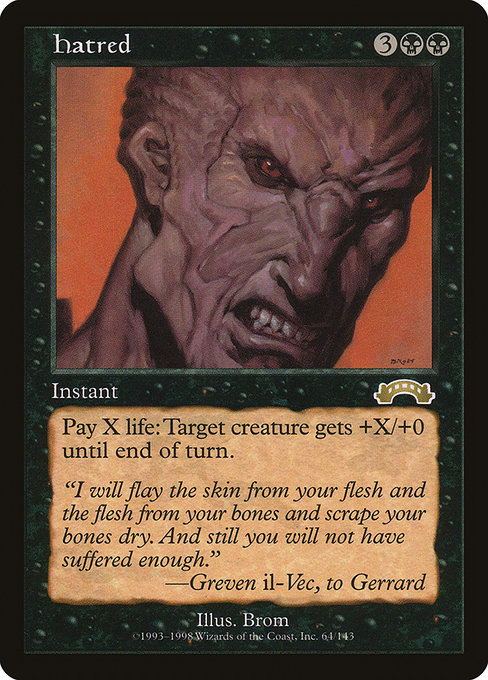
All of which is to say: I have no compunctions about hating on March of the Machine: The Aftermath for a simple reason. March of the Machine: The Aftermath is artless.
A fifty-card set released after March of the Machine, a culmination of a decade-long story arc in Magic and a plane-spanning struggle for the continuance of Magic’s multiverse, Aftermath could have been an elegy or a celebration. That name certainly implies it to be a coda, an epilogue that ties up loose ends and adds crucial context to March of the Machine. We could have seen final versions of dead heroes, or the agony and industry of rebuilding after a disaster, or how the war affected Magic’s societies in microcosm.
Instead we see all of this through unsatisfying hints because, per Mark Rosewater, Aftermath was modeled after Marvel movies’ mid-credits scenes–buzzy little snippets that reward the enfranchised and stoke anticipation for the next installment. These scenes serve a few purposes–a comedic break after the ponderous third acts of those movies, modulating audience expectations for the next film in the series, a tool for market research into character design for Marvel Studios–but they’re fundamentally disposable content designed to reward the diehards and squeeze out more content for the media apparatus that bolsters the Marvel Cinematic Universe.
It’s a cynical way to think of Aftermath, particularly when March of the Machine already had its own mid-credit scene in the Multiverse Legends card series. We got our Vampires riding Dinosaurs and our Ragavans and Kenriths running roughshod over Limited–why would we want to pay full price for another ride when the only thing you’re willing to offer is “ability words matter commander” and “collect all eight versions of a Lotus Cobra sidegrade?” More importantly, these Marvel credits sequences are included in the ticket price and are part of the original experience–you don’t have to return to the theater a month later and pay another $14.50 to watch Ant-Man quip for six minutes. Wizards of the Coast is asking us to queue back up and pay $70-$210 a box to get the Aftermath experience–that’s not building audience excitement, but closer to charging the choir to listen to the sermon.
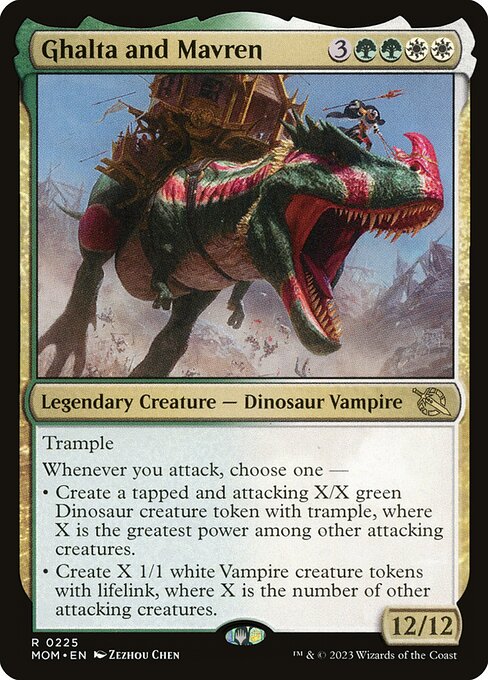
Were Aftermath a regularly-scheduled set full of regular cards or a boxed set series in the model of Secret Lairs, this would be one thing, but Aftermath is a 50-card set of Standard-legal cards sold in the booster pack model–both mini-boosters and Collector’s mini-boosters. Aftermath boosters contain five (“epilogue”) or half a dozen cards (“collector’s”) instead of the usual 15. This isn’t the first time Wizards has experimented with mini-boosters, but it has been ten years since that experiment ended.
Back in 2009, they released Conflux mini-boosters of six cards, which were sold exclusively at big box stores in the impulse aisle for $1.99 ($2.82 in 2023 dollars). These packs were much maligned as they had a “rare possible” slot instead of a guaranteed rare or mythic rare–it was entirely possible to open a $2 pack of six cards and receive four commons and one uncommon and nothing else. Since they were useless for Limited play and were a bigger gamble than regular boosters (which you could get for $3.99 at that time or cheaper if you went to a local game store), these were intensely hated by more enfranchised players. They served no function other than to be purchased–they reminded us of how simple the relationship between us and Wizards really is. These mini-boosters were discontinued after Magic 2014 and, as far as I can tell, went unmourned.
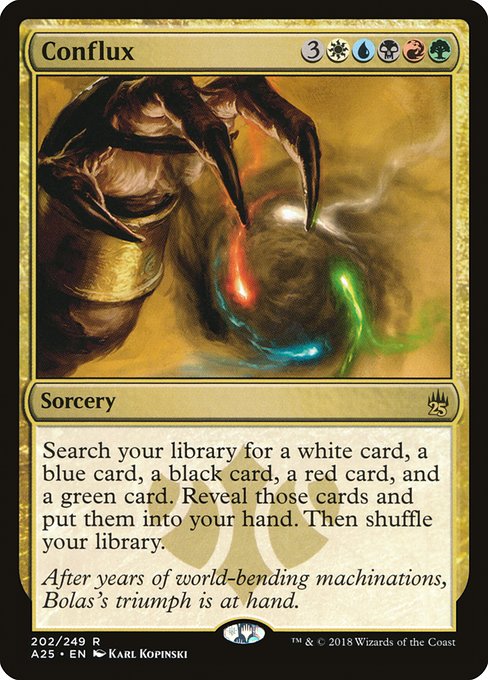
Unlike the previous mini-boosters, in your Aftermath packs, you’re guaranteed a rare/mythic from each pack and at least one foil; also unlike the $2 mini-boosters, you’re paying full price. Wizards’ PR team justifies this by pointing out you don’t receive commons in these packs–fair enough, but commons are a critical part of Magic and the booster experience. Even Collector’s Boosters of mainline sets include commons, albeit as foils. Commons remind us that we’re playing a game, not a lottery–when you take away commons, you lower the veil between “a fantastical game of chance and strategy” and “you just paid $4 for twelve cents of cardboard.”
That veil is pretty thin sometimes, but it does play an important psychological role: when you open a worthless booster, you can at least minorly delude yourself by thinking “well, this would have been a great pack if I was drafting!” or “I’ll save up all these useless cards and donate them to my old middle school!” It’s harder to do that when you shuffle through five cards and realize you traded half an hour at minimum wage for a double-mulligan hand.
The psychology of Magic is understudied, perhaps because we don’t want to scrutinize the ingrained mechanics of it too closely. A traditional booster pack of Magic: the Gathering weighs between 26 and 28 grams, or about an ounce. Back in the day, unscrupulous store owners would weigh packs on digital scales, believing the rumor that foils weighed slightly more. Inaccurate–basic fluctuations in materials and the vagaries of packing logistics means that booster packs naturally vary in weight–but persistent enough that you had people, like my store owner back in the early aughts, who bought medical calipers to measure packs down to the micrometer, as the foil layer added an imperceptible thickness to the card. Back then, foils were much, much rarer, and it was worth the expense (and the moral tariff) to tip the scales.
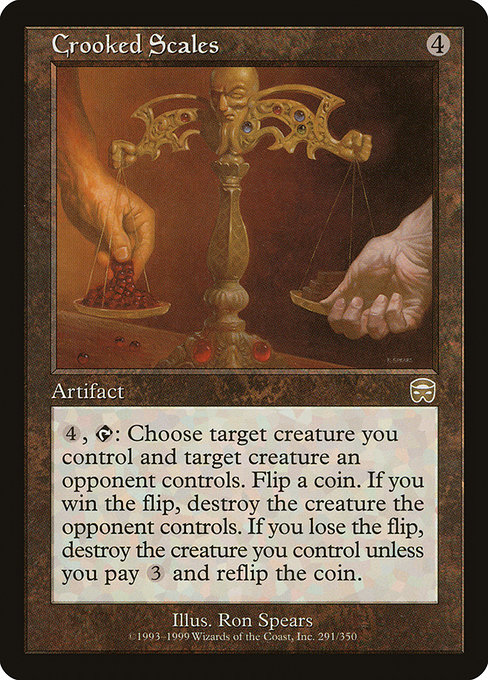
But if you’ve opened hundreds of boosters in your time, as so many of us have, you’re familiar with the weight of a booster pack. You may also be familiar with the promotional mini-packs that hold buy-a-box promos, “Collector’s Booster sample packs” in Commander decks, and FNM Planeswalker packs. These are a nifty little bonus, but there’s something uncanny about them–they open like a booster pack, but they don’t feel like one. There’s something off about the weight of it. It’s somehow perfect that March of the Machine: The Aftermath will come exclusively in these mini-boosters.
What is the intended audience for March of the Machine: The Aftermath? Well, here’s a hint: it’s not sold in Draft boosters. While Standard-legal, the caliber of cards is just a notch above Jumpstart and pitched heavily towards Legendary creatures–in other words, towards casual Commander. The card I’m most excited by is Urborg Scavengers, which is a hybrid of Graveyard Trespasser and Cairn Wanderer–a decent pedigree, but a pretty marginal card. There’s simply nothing to be excited about in Aftermath: a parsimonious single reprint in Training Grounds, a handful of fallen Planeswalkers who now read like Commander precon face cards, and some extremely conservatively-designed cards, from a restricted Gamble (Reckless Handling) to a shocking amount of “look at the top card of your library” wheel-spinning to the usual keyword goulash of cards like Samut, Vizier of Naktamun.
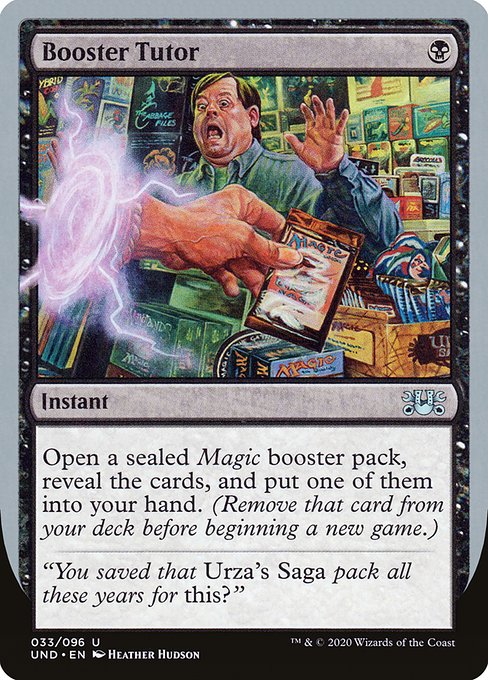
Without a Limited environment, Aftermath cards could have been designed to read outrageously–indeed, the bomb-heavy format of March of the Machine might even have been improved by Aftermath pilfering some of the heavier hitters. I wouldn’t complain if Ancient Imperiosaur switched places with Nissa. Instead, we have deposed Planeswalkers–whose powering-down took place off screen, diluting the narrative impact–and a couple dozen cards that interact with other cards, but to what purpose? Deification does something, to be sure, but what it does–card draw and Planeswalker protection–could easily be replicated by a Wall of Omens. We have Training Grounds with very few activated abilities, when activated abilities at a high mana cost could have symbolized our newly-fallen Planeswalkers struggling to recreate their powers and tied the Legendary Creatures into their vanished Planeswalker forms.
Righteous caviling aside, I’m not going to pretend as though Aftermath doesn’t have some interesting cards–I love playing Magic, and so any new cards are going to be exciting. It’s the set overall, and what it signifies, that I find demoralizing. So I’ll shut off the negativity and we’ll close with a handful of cards that suggest what Aftermath could have been:
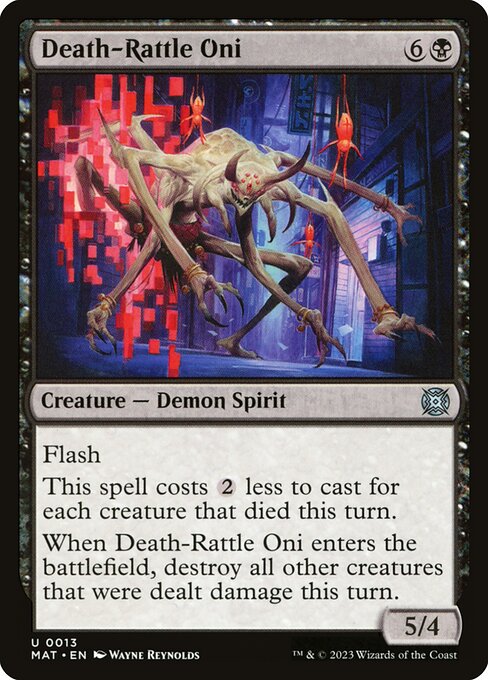
Death-Rattle Oni: A single trade in combat gets this Demon down to 2B for a 5/4. As a long-time admirer of Delraich and a fan of Kamigawa, I want the Oni to be good, so take this with a grain of salt. That said, cards with built-in cost reduction effects overperform, and Death-Rattle Oni’s cost reduction triggers off of something you already wanted to be doing. You Were Already Dead kills a wounded creature and draws you a random card; Death-Rattle Oni kills every wounded creature on the battlefield and gives you a 5/4. Any Pestilence effect that gets printed is worth considering alongside the Oni, and I’m sizing up Brotherhood’s End and wondering if that’s the core of a deck.
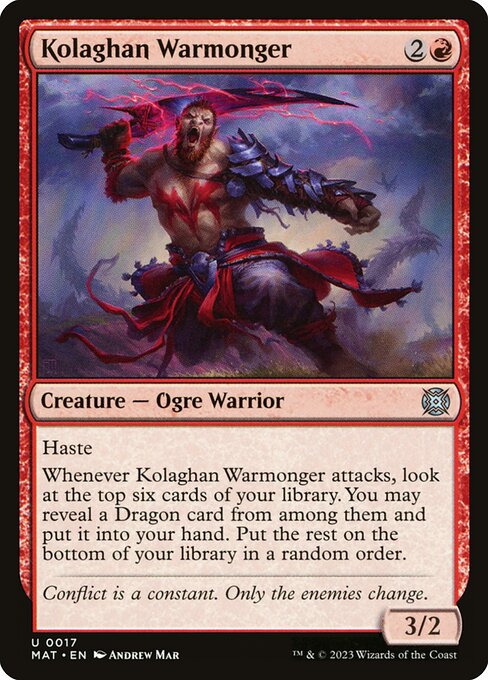
Kolaghan Warmonger: Between Invasion of Tarkir, Shivan Devastator, and the Kamigawa Dragons, there may be a Dragon deck in Standard–and if there is, Warmonger has a place. Smoldering Egg starts looking appealing when you have several cards that scale in power based on your Dragon count. As an aside, the fact that Warmonger is quite good really underscores how hilarious Bloodbraid Elf is–for one green mana more, you get a Black Lotus and never whiff on the card.
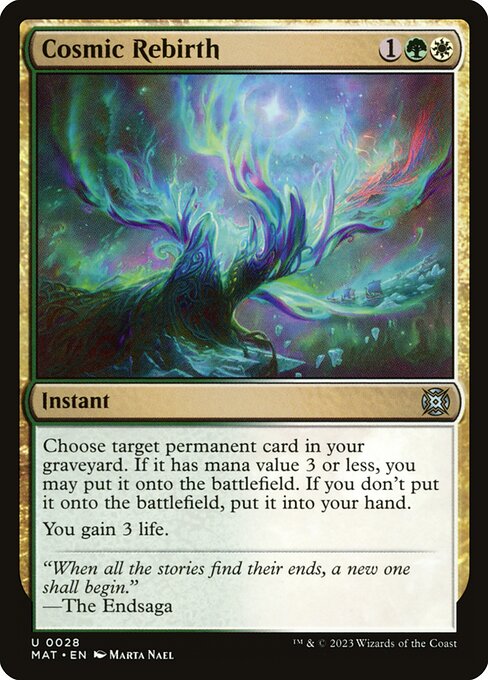
Cosmic Rebirth: Part Unearth, part Pulse of Murasa, Cosmic Rebirth does just enough of everything to be appealing. Getting back an Adeline, Resplendent Cathar, Loran of the Third Path, or a Fable of the Mirror-Breaker is pretty huge, particularly when you can do it at instant speed. Personally, I’ll be using it to buy back Phyrexian Dragon Engine.
I’m baffled by Aftermath. This is an experiment, and so I assumed it would be attractive to ensure success. Jumpstart in 2020 was an experiment, and Wizards flexed their creative muscle by designing new cards, frontloading the set with exciting reprints, and spotlighting undersupported archetypes and creature types. It was still sold in randomized boosters, and even at a slightly higher price point than traditional boosters, but it made that attractive through thoughtful design. Aftermath has no Allosaurus Shepherd, no Branching Evolution, not even multiple attractive reprints like Jumpstart’s Rhystic Study or Exquisite Blood.
The concept of March of the Machine: The Aftermath is solid at its base: provide Magic players a palate-cleanser that can easily be collected and that spotlights characters and events that didn’t get full screen time in previous sets. Where Aftermath fails is in product design–both the cards themselves and in being offered in five-card packs at similar prices to full-scale Magic sets. My disappointment in the set and what it could signify for future experimental products is intense, but again, only because I know what Magic can be at its best. I drafted Avacyn Restored, I bought Dragon’s Maze, I played during Eldrazi Winter–I also know what Magic can be at its worst. Aftermath, in taking inspiration from Marvel movies, proves that it can fuse the worst of Magic with the worst of mass market cinema and create something new and undesirable.
Rob Bockman (he/him) is a native of South Carolina who has been playing Magic: the Gathering since Tempest block. A writer of fiction and stage plays, he loves the emergent comedy of Magic and the drama of high-level play. He’s been a Golgari player since before that had a name and is never happier than when he’s able to say “Overgrown Tomb into Thoughtseize,” no matter the format.

